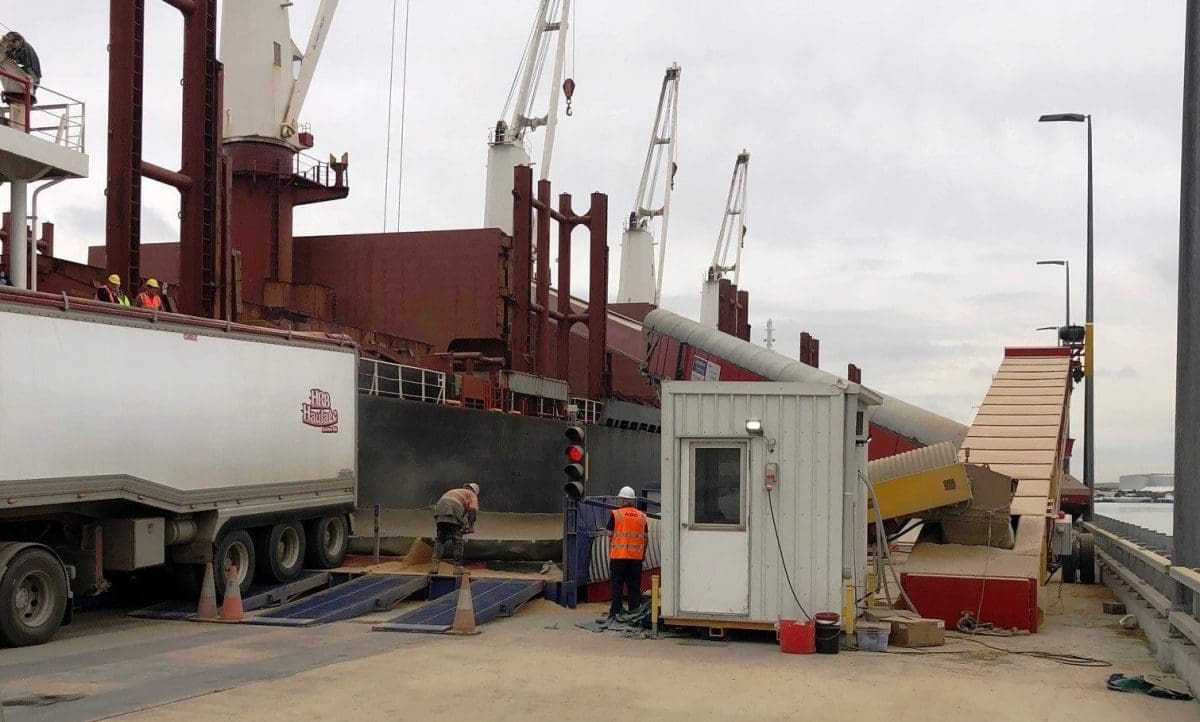
RainAg last week loaded its first vessel on behalf of clients at the Wagners wharf at Pinkenba. Photo: Mobile Conveying Services
BRISBANE has joined Adelaide and Portland as the third Australian grain port with two mobile shiploaders in operation.
Jointly, they are expected to be able to add up to 1 million tonnes to Australia’s annual bulk-grain export capacity at an opportune time as eastern Australia heads into what is shaping up to be its third bumper wheat harvest in a row.
The sites, at Pinkenba on the north shore of the Brisbane River, have already added delivery points to supplement longstanding capacity at GrainCorp’s Fisherman Islands terminal and Wilmar’s Queensland Bulk Terminals on the south shore.
Arrow, RainAg initiatives
Arrow Commodities is an Australian trading company which has for many years been exporting cargoes out of New South Wales, and is a key customer for the Quattro terminal at Port Kembla and the Newcastle Agri Terminal (NAT).
It did its first cargo ex Pinkenba in January, and is using the public wharf to ship grain it accumulates at nearby bunkers.
Arrow has loaded more than 10 vessels at Pinkenba this year, some of them two-port loads to fit in with draft restrictions.
Its most recent load at Pinkenba, the Aquataurus, is berthing at NAT this week to top up with wheat.
Broker RainAg is using the privately owned Wagners wharf nearby, which opened in 2018, primarily to receive cargoes of cement clinker for use in Wagners’ Toowoomba-based business.
“At the moment, we’re looking at one cargo a month, and we would like to ramp up to two a month,” RainAg director Ian Grellman said.
Its first, the African Quail, left the Wagners berth yesterday bound for Indonesia, with 27,500t of wheat on board.
Mr Grellman said RainAg was sourcing grain mainly from grower storages due to an anomaly which has developed in the Brisbane market.
“While the drought was on, plenty of merchants were doing ex-farm business, and then when the volume turned up, all of a sudden all the big guys were not touching trucks if they didn’t have to.
“That’s because there’s a lot less risk for them if they’re buying delivered Brisbane.”
As a result, bids for grain stored on farm on the Darling and Western Downs and into the NSW border region were missing spikes in the market based on export demand, mainly due to the expense and shortage of road freight.
With its relationship with carriers built through brokering grain and cotton, RainAg saw an opportunity to provide a fee for service to exporters unable to book at the two terminals on the south side of the river.
Northern model
Riordan Grain Services (RGS) has been exporting bulk grain from Geelong and Portland in Victoria since 2017, and uses a mobile shiploader at each port to load grain brought direct from farms and from accumulation sites.
With its own fleet of trucks as the backbone to its supply chain, the Riordan model has helped to give growers better access to delivered-port pricing.
Arrow Commodities wheat trader Tom Nixon made reference to the generosity in time of RGS managing director Jim Riordan, who he said has created the opportunity for alternative export pathways through his initiative and persistence in Victoria.
Mr Nixon also noted the collaborative approach from the Port of Brisbane and Federal Department of Agriculture.
The ability of Arrow to accumulate and load its own cargoes, and RainAg to provide a fee-for-service operation, are the reverse of the process developed by Boolah Commodity Management during the drought.
It handled around 40 cargoes of grain shipped from southern Australian ports to Pinkenba to fill the void left by the 2017-19 drought.
While Boolah used trucks to ferry grain to bunker sites leased at Pinkenba, Arrow and RainAg are trucking grain from leased sites to the wharf to tip into hoppers to feed shiploaders.
The mobile shiploaders being used at Pinkenba are believed to be seventh and eight built for grain exporting and in regular use in south-eastern Australia, with three each in operation in South Australia and Victoria.
Grain Central: Get our free cropping news straight to your inbox – Click here



HAVE YOUR SAY